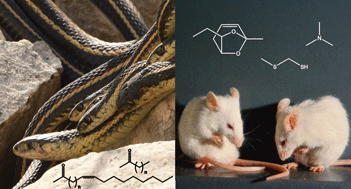Chemical signals in terrestrial vertebrates: search for design features
Abstract
Covering: 1950 to 2015
We compiled a data set of the compounds that terrestrial vertebrates (amniotes) use to send chemical signals, and searched for relationships between signal compound properties and signal function. Overall, relationships were scarce and formed only small-scale patterns. Terrestrial vertebrate signalling compounds are invariably components of complex mixtures of compounds with diverse molecular weights and functionalities. Signal compounds with high molecular weights (MWs) and low vapour pressures, or that are bound to carrier proteins, are detected during direct contact with the source of the signal. Stable compounds with aromatic rings in their structures are more common in signals of social dominance, including territoriality. Aldehydes are emitted from the sender’s body rather than from scent marks. Lipocalin pheromones and carriers have a limited range of MWs, possibly to reduce the metabolic costs of their biosynthesis. Design constraints that might channel signal chemistry into patterns have been relaxed by amniote behavior and biochemistry. Amniote olfaction has such a high sensitivity, wide range and narrow resolution that signal detection imposes no practical constraints on the structures of signalling molecules. Diverse metabolic pathways in amniotes and their microbial commensals produce a wide variety of compounds as chemical signals and as matrix compounds that free signal components from the constraints of stability, vapor pressure, species-specificity etc. that would otherwise constrain what types of compound operate optimally under different conditions.

- This article is part of the themed collection: Chemical Ecology

 Please wait while we load your content...
Please wait while we load your content...